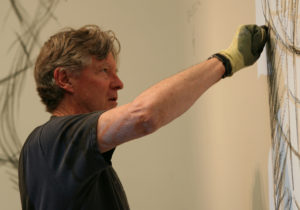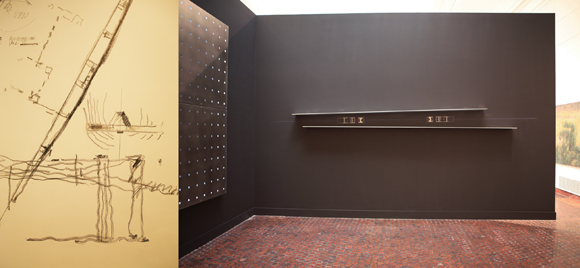
Jim Jennings and Neil Denari Receive the American Academy of Arts and Letters 2008 Academy Award for Architecture.
It’s not every awards ceremony at which, on a drizzly late-May afternoon in an upper Manhattan, Beaux Arts hall—organ strains of a masterfully performed Charles Ives canzonetta in F having, moments earlier, only sweetened the air of cultured, faintly cosseted well being—the key address takes aim at the attendees. Particularly when that group comprises Jules Feiffer, Alison Lurie, John Ashbery, Richard Artschwager, John Baldessari, Kevin Roche, FAIA, and a good number of their peers.
“Oh, yes,” the playwright-actor Wallace Shawn affirmed (in that voice) midway into his remarks to the annual convocation of the American Academy of Arts and Letters, “speaking of superiority, we ought to note that pretty much all of us here in this room are connoisseurs of superiority. Those enrolled in the Academy belong to one of the very few organizations in the country whose central function is to proclaim the superiority of its own members. And those in the audience are people who enjoy looking at people who have been called superior.”
His theme being global aggression (“The defense of privilege, the center of our lives for such a long time, is grim, exhausting…the feeling of superiority is not the only source of human satisfaction: imperial dreams are not the only dreams”), he incorporated the role and consequence of art. “People beguiled by the beautiful are less dangerous to others than those obsessed by the thought of supremacy…. If the art we create is beautiful enough, will people be so drawn to looking at it that they’ll leave behind their quest for power?” The notion was a romantic one. And it was, inescapably, a superior choir of artists, writers, composers and architects to whom Shawn, in that sublime setting, was preaching.
The American Academy of Arts and Letters is an august, 110-year-old New York institution of 250 honorary members, elected for life. From the outset, annual prizes have been given for literature, music composition, painting and sculpture. In 1991, an Academy Award in Architecture was created (for an individual or partnership) “to recognize an American architect whose work is characterized by a strong personal direction.” A second architecture award with the same purpose was added in 2000.
After the inaugural award to Rodolfo Machado, Assoc. AIA, and Jorge Silvetti, Assoc. AIA, California architects had a run for the next three years: Thom Mayne, FAIA, and Michael Rotondi, FAIA, in 1992; Franklin Israel in 1993; Craig Hodgetts, FAIA, and Hsin-Ming Fung, AIA, in 1994. It was conferred upon Eric Owen Moss, FAIA, in 1999; Greg Lynn in 2003; Wes Jones in 2007.
This year, for the first time, the Academy Award for Architecture recipients are two California architects not in partnership together: Neil Denari, AIA, and Jim Jennings, AIA. The 2008 selection committee, chaired by Henry Cobb, FAIA, and made up of AIA Fellows Steven Holl, Peter Eisenman, Richard Meier, Billie Tsien, Michael Graves, Charles Gwathmey, James Stewart Polshek, Hugh Hardy and Cesar Pelli, along with Ada Louise Huxtable, Hon. AIA, drew from a field of 36 candidates nominated by themselves and other members of the Academy. The vote—for both Jennings and Denari—was unanimous.
The citations:
Neil Denari was exposed to aeronautical engineering at Airbus just after architecture school. From this experience, he developed an intuitive grasp of the importance of structure, an interest in the defiance of gravity and a sensitivity to economy in the design of a building’s envelope. These have profoundly informed his architectural ideas as well as his extraordinary architectural drawings. In making the transition from theoretician and teacher to designer of elegantly inventive and rational buildings, he has never compromised his values or his respect for the venerable “rules” of architecture.
The strong personal direction of the works of architecture realized by Jim Jennings has evolved slowly toward a personal perfection over many years. Inspired proportions, mysterious serenity of light and space, and intensity of materials and details have consistently characterized what has become an example of an architecture of inspired silence.
For Jennings, the good news was notice of the award itself—the slightly crazy-making news was that the lead time for designing, making and putting up the accompanying exhibition was a month. He decided to improvise: covering three walls totaling 12 by 38 feet, he used graphite to sketch elevations and details of various projects. Opposite that, he hung, on adjoining panels, a cantilevered anodized-aluminum model of Visiting Artists House and a to-scale, backlit, stainless-steel detail of SOMA House. The New York office of general contractor Ryan Associates coordinated the fabrication and installation of the model and detail; Dan Dodt designed the lighting component and oversaw its positioning (initially, David Meckel, FAIA, had offered student power when it was seemingly going to have to be built and shipped from San Francisco). In the end it was a fast-assembled coalition of the willing—and one guy marking up some fairly venerable walls.

“Drawing shows a different side of architecture—more related to the process of making it than the result,” Jennings said. “The other reason I went that route was that I don’t have a warehouse full of $50,000 models.” In Cobb’s estimation, the Academy wasn’t slighted: “The exhibit Jim mounted was notably fresh and inventive in its use of the space and surfaces made available to him.”
Denari approached the gallery show altogether differently: using binder clips on push pins to display prints of seven projects. “About five years ago,” he explained, “we developed a strategy for exhibits when plans, details and models are optional—and that was to go cinematic. Because this one was self-curated, and we could do whatever we wanted, the idea was to get the images as big as possible, in a plain, straightforward but very considered way. Print them ourselves and hang them on the wall. See how much information could be generated per image.”

Denari was speaking in Helsinki and couldn’t be in New York for the ceremony. When told about the Shawn address, he expressed bemusement. “Superior? The word is loaded with cultural elitism and self-referentiality. But this thing is prestigious—there aren’t too many steps up in the awards chain. In terms of what Wallace Shawn was getting at, and thinking about the award with a degree of humility, at the very least it’s based on one’s work rather than on one’s status otherwise.”
Author Therese Bissell is a design writer and editor whose work has appeared in The New York Times, Architectural Record, and World Architecture. She is a contributing writer for Architectural Digest and last edited Towards a New Museum for Monacelli Press.
Originally published 3rd quarter 2008, in arcCA 08.3, “Engineering + Architecture.”





